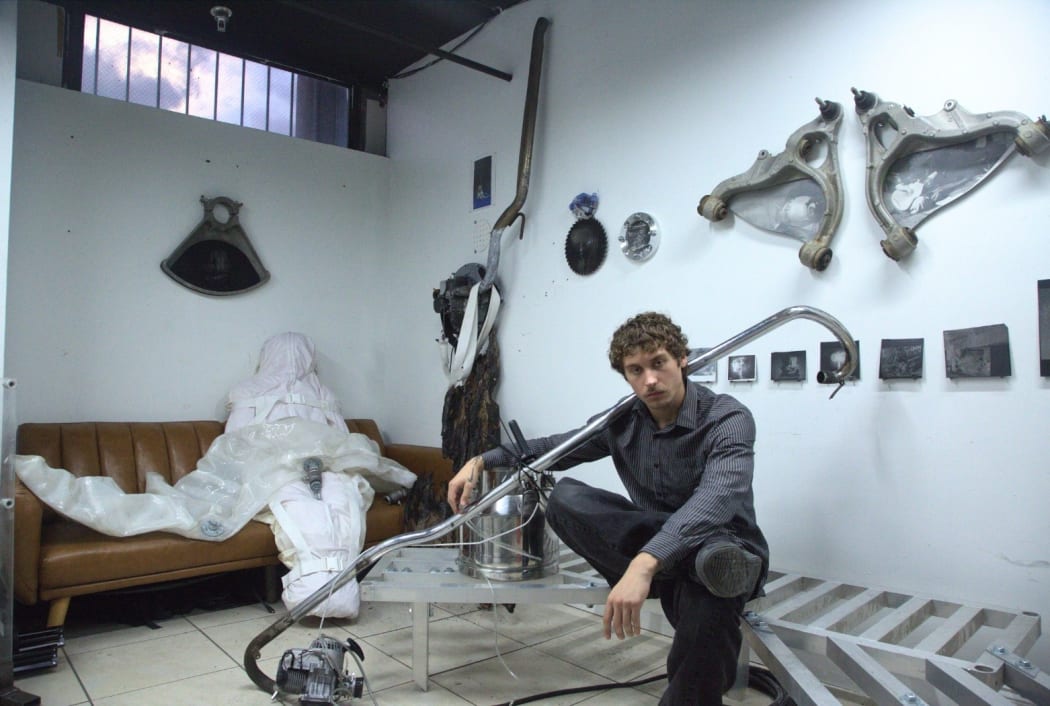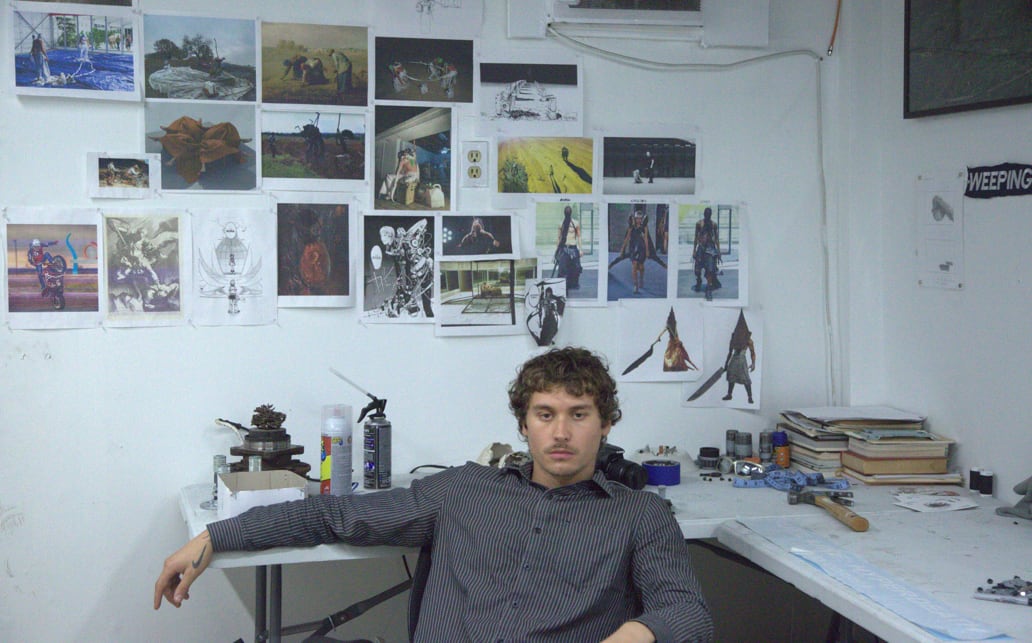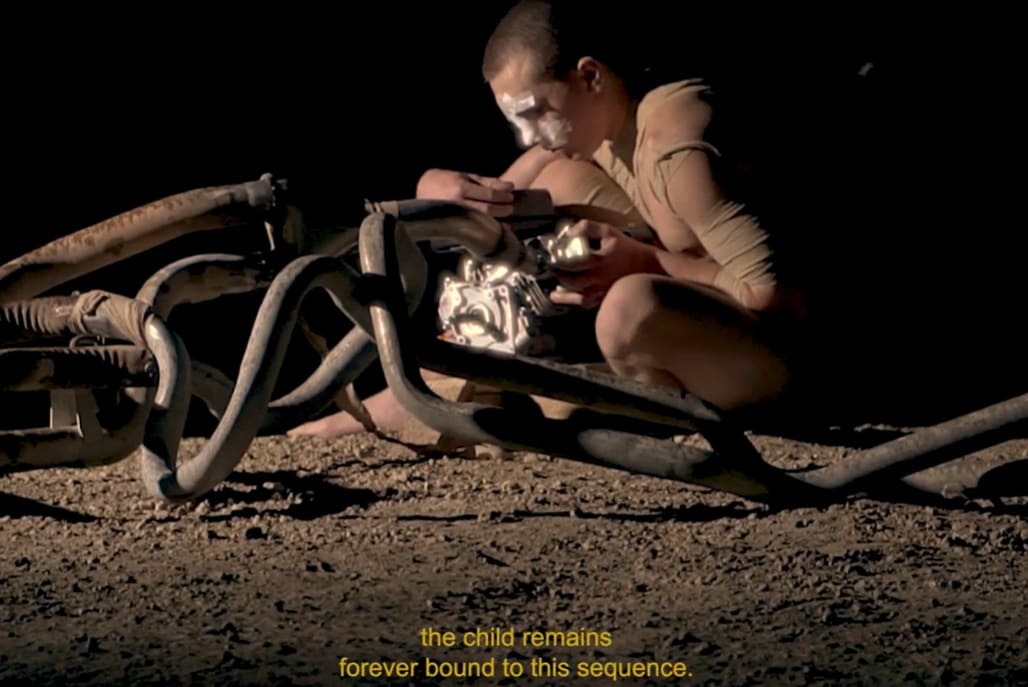
DAVID CORREA X Q MAGAZINE INTERVIEW #2,
Recorded on September 23rd, 2025.
CC: In our 2023 interview, we spoke about the trials of being a performance artist—from explaining the purpose of the work, to the labor of building props and settings, to the fleeting nature of the performance itself. How has your perspective on performance, preparation, and ephemera evolved since then?
DC: Hi Cat, I should go back to the body of work that really started my contemporary practice, the Death in Dade series, the work had to be performance because it was literal. I was taking gas-powered tools and stripping them of their function, rendering them useless. That whole process—from the modification of the objects to their use and presentation, was a form of rebellion. It was a very literal protest. I was bastardizing these tools, which is why the work demanded performance. When these characters and narratives began recurring in the work though, I felt it couldn’t remain performance anymore. It felt like I wasn’t allowed to, because I was pretending. I had become an actor playing surreal roles. This allowed me to play further into the metaphor of death, and the work became theatrical, play and pretend were at its core. That’s why I felt the practice was calling me toward film, and toward theater.After those performances the objects aren’t presented as sculptures. They’re equipment, tools that had been activated in performance, and afterward they only exist as relics of that ephemeral process. The performance itself was the artwork. You had to be there in those 15 or 20 minutes to witness it, and once it ended, the work no longer existed. All that remained was material evidence.
Now, moving into film, I’m thinking more about these transitions. During my time at Skowhegan, I had a studio visit with Trajall Harrell, the choreographer, which further shaped how I approached this direction.What he did for me was question the idea of performativity, and who gets to define that. For me, performance always had the need to be real. It was rooted in Marina Abramović and her contemporaries' approach, where the blood is real, the tears are real, the actions are real. If I see blood in a performance, I think of it as blood. If I see fake blood in a play, I suspend disbelief and think of it as blood anyway, because I know it’s trying to tell me a narrative. What Trajall made me question is: who defines performativity? Am I allowed to play, to pretend, and fake out my audience? Who knows if I do or don’t?
I think I have a lot more questions about performance than I used to—and I think that’s a good thing.
CC. How do you distinguish between works you see as sketches, research, and ephemera of a larger project versus a piece you confidently call and consider a tangible artwork? Why is that distinction personally significant for you?
DC: If I tell you an object is an artwork, then I’m assigning it so much importance, elevating it above all its surrounding objects and its environment. But for my performances, I want the work to remain ephemeral. The core of this is the commodification of an art practice….I don’t want to sell you an artwork. I want the artwork to be experiential. I want you to see a performance, to experience a film.
Everything else—the objects and sketches, exist to inform the artwork that you either were or weren’t there to witness, but that existed at one point in time. It’s almost like I’m presenting my practice as a history museum. I’m self-anthropologizing in a way, collecting the relics of this practice. An audience is welcome to purchase or exhibit those items as a way of supporting my practice, the artwork itself being the narratives I’m telling and the worlds I’m creating. Does that make sense?
CC: I think that made sense. I feel like the distinction you mentioned between pieces that might otherwise be seen as ornamental or accessories for another project—applies here. Your pieces still carry importance and permanence because they inform the larger project. They’re not simply aesthetic objects; they’re important because they contribute to a larger body of research. They’re not adornments..they’re integral to its very being. And I think that’s an important distinction.
DC: True, they’re not adornments, and that sense of permanence is frustrating to me. I dislike the desire artists have to self-aggrandize. Let me reframe that: I prefer to think of these pieces as equipment and reference material, rather than adornments, and also rather than artworks.I think the desire for permanence in an object drags us down as artists. We should be aware of, and even embrace, the ephemerality of artwork. Even the decay of an object can be essential to a practice. To define these objects as “artworks” alone feels like an act of self-importance.
CC: You recently returned from a residency at the prestigious Skowhegan in Maine. How has your practice matured through the philosophical, historical, and studio research you did there? In particular, how has the narrative element—so central to your work—developed?
DC: I knew I was interested in moving toward narrative, that’s why Weeping a Petroleum Lubricant emerged from the Death in Dade series, and why Fuel Line: Hyperdeath is the next film in that body of work. But it wasn’t clear to me just how important narrative is to the entirety of the work, or how deeply narrative-based my practice really is, until Skowhegan. I realized that my work needs to fully embrace narrative and world-building through the characters I’m creating. At the same time, I came to understand that it doesn’t always have to take the form of film. I can return to performance, exploring these narratives in ways that allow them to shift my idea of performance into something closer to theater.
CC: Your work is often described as masculine-oriented. What does masculinity mean to you in the context of your art?
DC: Having my work rooted in the idea of labor and all the notions surrounding it is what originally brought about this masculine element. It’s something I’ve been surrounded by my whole life, and the jobs I’ve worked have informed my practice. It wasn’t until recently that I began finding these deeper connections, and a lot of that is thanks to The Carrier Bag Theory of Fiction, an essay by Ursula K. Le Guin that made me think about masculinity as being objective-oriented.
My practice has always been focused on objectives—whether that’s protesting against objective, embracing it, or questioning it and blurring the lines between purpose and task. In Western culture, masculinity is often defined as being objective-driven, and that plays directly into this body of work. It also raises the question: what happens when masculinity isn’t objective-driven? The essay I mentioned talks about the first invention being the vessel, something that gathers, that takes in fruit—versus the second invention, the arrow, which drives toward an objective and reaches its climax. That's the plot structure, its exposition, rising action, climax, and resolution. So what does it mean to imagine masculinity shaped by the vessel rather than the arrow?

CC: For your upcoming exposition at Tunnel Projects on October 3rd, you’ll be premiering a new film, Fuel Line: Hyperdeath. Last August, I had the honor of curating your one-night film screening Weeping a Petroleum Lubricant at YoungArts, but before then you rarely considered even the video documentation of your performances as film. What drew you toward film, and do you see it as your current ideal medium?
DC: I don’t see film as my ultimate medium. I think I was heading in that direction because the surreal element became so important and critical to the work. I was creating otherworldly scenarios and building another universe with impossible characters living along these eternal timelines.
At that point, performance no longer felt possible. I was pretending, playing a character, as I mentioned earlier, which made me feel the work had to shift. To answer the first part of the question: I wouldn’t consider the video documentation of my earlier performances to be film, because they were just that—documentation. They weren’t the art object. In contrast, with these new works, the film itself is the artwork. With performance, the artwork only existed in the moment which you witnessed it. What remained afterward was documentation, evidence of the artwork.
CC: In your first film, Weeping a Petroleum Lubricant (2024), the central figure felt like a young man, and in the accompanying text we comfortably referred to him as “the boy.” In this new film, however, I no longer see a boy—we see a man, with visible chest hair, a full beard, and a deep voice (which we can assume narrates the entire film, though this isn’t confirmed while watching). Was this shift from boy to man something you considered when casting the actor who plays the “Fuel Bladder”? And if so, why?
DC: In that first film, the character is referred to as a boy to emphasize his naivety. It’s clear in the text, this foolishness, represented through the boy attempting a protest and failing. In contrast, the Fuel Bladder in Fuel Line: Hyperdeath acts as the antithesis to that boy character. Instead of protesting the situation, he fully embraces it and accepts it. In that embrace, he’s no longer seen as naive. It’s a hopeless way of looking at this dead world he inhabits, but that’s the point of the work.

.......Within these interconnected narratives, these evolutions across the two films—I see the boy and the man as two sides of the same coin. They’re complete opposites: one tries to assert his subjectivity by rebelling against the tool and fails, while the other denies this subjectivity, embracing the tool and becoming it.
CC: In your new film Fuel Line: Hyperdeath, what symbolic role does the recurring image of the burning sun and horizon line play? The sun also features heavily in your script/poem that accompanies the film, for example:
"Certain…my resolution is…to die.
I have been painted by this sun…thousands of lifetimes over.
A system of tissues and organs…likened to a still life.
I am the sun’s greatest masterpiece."
DC: I see the sun as a kind of deity figure now. In thinking about my practice as a whole, with its focus on combustion and the combustion engine, I’ve been considering how so many of humanity’s major inventions are rooted in the discovery and creation of fire. Across cultures and religions, the sun has long served as a god figure. In the film, the sun appears as an eternal observer, always looming over the character. I came across something on Reddit that resonated with this idea: that humans traded their furs and digestive enzymes for the ability to harness fire. Maybe everything we create stems from this desire to harness God.
CC: In many of your past performances, as well as in this new film, vastness and open space often serve as the backdrop for the narrative. These expanses give your scenes and characters a sense of collapsing time. What does the negative space you so consistently employ reveal about the “positive” within these works?
DC: That vastness is vital to the work. It’s why these two pieces specifically needed to be filmed. Film separates them, placing the characters on an entirely different timeline, in an entirely different universe. It decontextualizes them, removing any recognizable environment. Nothing else informs their situation outside of the time and space presented to the viewer. They exist solely and eternally within that frame.
CC: Could you share a bit about your transition into writing more consistently within your practice? In your new film, for instance, you carefully composed the poem recited by the “Fuel Bladder” character which runs for the entirety of the film.
DC: I don’t know if I have a clear answer to this yet. The writing began with a monologue I performed in 2023 for Untitled, and it’s been growing since then. It’s pushed me further into film and now possibly into theater. Writing has become a way for me to explore the characters, their thought processes, their worlds.
CC: What do you hope visitors will feel or take away from experiencing your new film alongside the accompanying artwork installed for this Tunnel Projects opening?
DC: As for what I hope visitors will feel or take away from experiencing the new film alongside the accompanying installation at Tunnel Projects..I think more and more, I care less about what the viewer feels or sees. It’s important to consider your audience, of course, but I don’t want that to dictate the decision-making in my practice. In a way, this is an intuitive shift, and it’s something new I’m allowing myself to explore.
DC: There’s a quote I like. I don’t remember who said it or where I heard it, but it goes something like, we will not only take the fruit, but feed the soil. This line is an extension of that. It’s about this character returning to the soil, not only metaphorically but literally, giving everything back to the land, and once again, into that empty vastness. Its both self aggrandising and futile.
CC: Thank you David, I look forward to seeing your show at Tunnel Projects on Oct 3, 2025.
